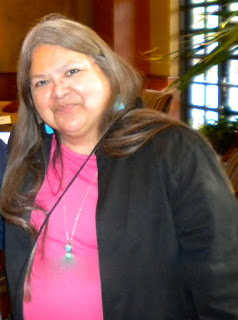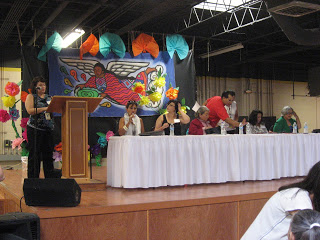December 12, 2012
Compañeras, hermanas, hijas, nietas, abuelas, madres, madres, madres, todos somos madres, de una manera u otra, porque todas tenemos la profunda capacidad de crear:
Hoy es un dia muy importante, today is an important day, 12/12/12, there will not be another one in our lifetimes, we must give ourselves a moment in our lives to stop our ordinary activity and feel, see, touch, taste, smell, be with the Earth, the Mother of Us All, y darle Grácias. This is the day that tells us that it is time to be the way we want to be, without reservation, unconditionally, to realize ourselves con firmeza, con coraje, con Amor, to remember who we are, as mujeres, as guerreras, as voces, as thinking hearts.[1] Today is a llamamiento to our very innermost beings to stand up and be counted on behalf of the Earth, on behalf of all of Life, on behalf of toda la naturaleza, todos los seres inocentes que comparten esta planeta con nosotras. De nosotras dependen, quién sino nosotras? Humans are not the only peoples on this Earth. Si va a ver Justicia, que sea para todos los seres que vivimos en la Tierra. Interestingly, the U.N. designated April 22 as International Mother Earth Day (I knew it was called Earth Day, I just learned it is officially Mother Earth Day). Día 12 is the Mexican Mother Earth Day. Perhaps not all peregrinos, devotos, would see it this way—for many of them, la Virgen de Guadalupe es, en términos estrictamente Católicos, la Madre de Diós, la Madre de Jesucristo, la interlocutora mas alta que hay para llegar a Diós. Mis respetos a todos ellos.
But for those of us who have been reflecting on her being, thinking about our (dis)connections to Catholicism, thinking about Chicana/indigenous spiritualities, envisioning “transnational feminist spiritual communities,”[2] coming to terms with the idea of Spirit in our lives, we know that La Virgen is much more than how she is defined by the Catholic Church. We know her differently. As our beloved Gloria Anzaldua said, “I’ve always been aware that there is a greater power than the conscious I. That power is my inner self, the entity that is the sum total of all my reincarnations, the godwoman in me I call Antigua, mi Diosa, the divine within, Coatlicue-Cihuacoatl-Tlazolteotl-Tonantzin-Coatlalopeuh-Guadalupe—they are one.”[3] This is immense knowledge. La Virgen se manifiesta como imagen Católica, some say she was an invention of the missionization campaign, a tool of the imperial project, pero de todas maneras, we have triumphantly (re)indigenized her, claimed her as our own, and she has become an activist on behalf of the people, for so many who know her this way. If she was an invention of missionization, the invention traicionó al proyecto colonial, because the foundational elements of her being are here, in this hemisphere, in the Land. She is the Land. She is the Earth. Punto.
Today is 12/12/12, but we should see the date as a marker of the momentum of transformation that is happening all around us. The latter part of the month, some say 12/21/12, will mark the entrance, completed, of the next age, the New Sun. My colleague Victor Montjeo, Jakaltek Maya, from Guatemala, tells us that this is a time of world renewal, not world destruction. In the Conchero Dance tradition, I was told that we are moving from Nahui Ollin, 5 Movement, the age we have been in since before the invaders arrived, to the New Sun, Nahui Coatl, 5 Serpent, and that this New Sun will manifest more predominantly as female, and her symbol will be the Venado, the Deer. For at least two decades, the elders of this dance tradition have indicated that the New Sun has been arriving, coming in behind the present one, dancing. I remember dancing at the Basilica de la Virgen de Guadalupe in Mexico City, one December 12th, and suddenly as I was dancing, I felt the earth move beneath my feet, gently, almost unnoticeably, but it was certain, the Earth Mother was dancing with us, happy that we were dancing for her. She is so alive, she sings, she dances, she witnesses, she grieves, she disrupts, she balances, she suffers, she loves.
During this time (during all of our time on this earth in this life), we should walk, as the Yoeme say of saila maaso, the little brother deer, leaving flowers wherever we step. Tenderly, gracefully, attentively, with abundant awareness of our surroundings, not only our academic or work surroundings, that, too, but our homes, our yards, our jardines (if we are lucky enough to have them), the spaces where we choose to spend time. Spend time, such a Western concept. Even time is cast in monetary, acquisitive terms. Spend time. Take time. Waste time. Don’t waste time. The spaces, circles, spheres where we love to be.
We know we are always in Nepantla (grácias a los antiguos Nahuas por este concepto). Somos Nepantleras (grácias a Gloria por la contemporización del concepto). As Nepantleras, in this time of great transformation, change, shape-shifting, we are ready for whatever comes our way. We must keep our senses, have our wits about us, trust our intuition, and constantly fine-tune it, remember humility, and know deeply that our Spirits are present, always. My Spirit guides me, my Spirit has the answers, my Spirit protects me. This I must remember. This we must remember. And my Spirit helps me see the signs of this new time that has come. Our spirits are ready. This time is our time.
Inés Hernández-Ávila is a Professor and Chair of the Department of Native American Studies at UC-Davis. She is a member of the Mujeres Talk Editorial Collective.
[1] The term “thinking heart” is from Kathryn Shanley, Nakota scholar of Native American Studies.
[2] Theresa Delgadillo, Spiritual Mestizaje: Religion, Gender, Race, and Nation in Contemporary Chicana Narrative, p. 94.
[3] Gloria Anzaldúa, Borderlands/La Frontera: The New Mestiza, p. 50.
With all the end-of-semester chaos, commercialism, and high expectations from family and friends, I found this blog very grounding. Thank you for that gift!


